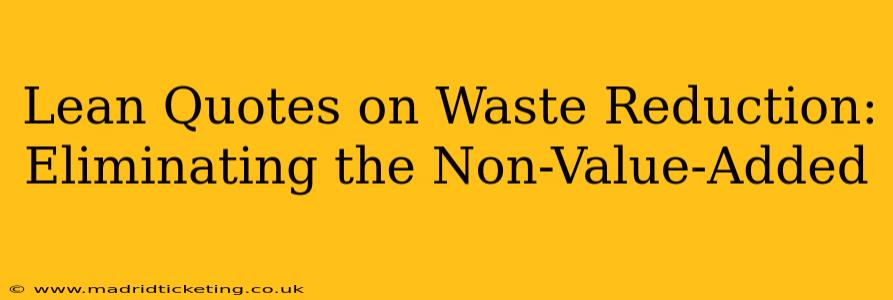In the lean manufacturing philosophy, waste—also known as muda—is the enemy of efficiency and profitability. Eliminating waste isn't just about saving money; it's about optimizing processes to deliver maximum value to the customer. This article explores powerful lean quotes that encapsulate the essence of waste reduction, focusing on identifying and eliminating non-value-added activities. We'll also delve into common types of waste and how to tackle them.
What is Muda (Waste)?
Before we dive into the quotes, let's establish a common understanding of muda. In the lean manufacturing context, muda encompasses seven primary types of waste, often remembered by the acronym TIMWOOD:
- Transportation: Unnecessary movement of materials or products.
- Inventory: Excess stock that ties up capital and space.
- Motion: Unnecessary movements by people or equipment.
- Waiting: Idle time waiting for materials, processes, or information.
- Overproduction: Producing more than is needed or demanded.
- Over-processing: Performing more work than necessary to meet customer requirements.
- Defects: Errors and imperfections leading to rework or scrap.
Often, an eighth waste, Non-Utilized Talent, is added to highlight the untapped potential of the workforce.
Powerful Lean Quotes on Waste Reduction
Here are some impactful lean quotes that resonate with the core principles of waste elimination:
"The goal is to eliminate waste, not just to reduce it." This powerful statement emphasizes the transformative nature of lean thinking. It's not enough to simply decrease waste; the ultimate aim is to completely eradicate it wherever possible. This requires a relentless pursuit of perfection and continuous improvement.
"Waste is anything that does not add value to the product or service from the customer's perspective." This quote highlights the crucial customer-centric aspect of lean. Waste is defined not by internal processes, but by the value delivered to the end user.
"The key to reducing waste is to identify and eliminate the root causes of the problem, not just the symptoms." This underlines the importance of deep analysis and problem-solving. Simply addressing the visible effects of waste is insufficient; a thorough investigation into the underlying causes is necessary for lasting improvement.
"Continuous improvement is not a destination; it's a journey." Lean is a dynamic process. Waste reduction is an ongoing endeavor, not a one-time project. The pursuit of perfection requires constant vigilance, adaptation, and innovation.
"Waste is often hidden in plain sight." This quote reminds us that waste isn't always obvious. It requires careful observation and analysis to uncover hidden inefficiencies and non-value-added activities.
Common Questions about Waste Reduction
How can I identify non-value-added activities in my process?
Identifying non-value-added activities requires a systematic approach. Use tools like value stream mapping to visualize your process and pinpoint areas where time and resources are spent without adding direct value to the customer. Engage your employees – those closest to the work often have the best insights into inefficiencies.
What are some practical steps to reduce waste?
Practical steps include implementing 5S (Sort, Set in Order, Shine, Standardize, Sustain), Kaizen (continuous improvement events), and Poka-Yoke (error-proofing). These tools provide structured approaches to systematically identify and eliminate waste.
How can I measure the success of my waste reduction efforts?
Measure your success by tracking key performance indicators (KPIs) such as cycle time, lead time, defect rates, and inventory levels. Regularly review these metrics to monitor progress and identify areas for further improvement.
What is the role of employee involvement in waste reduction?
Employee involvement is crucial. Their firsthand knowledge and experience are invaluable in identifying and eliminating waste. Empowering employees to participate in improvement initiatives fosters a culture of continuous improvement and ownership.
By embracing the principles embodied in these lean quotes and actively pursuing the elimination of waste, businesses can achieve significant improvements in efficiency, productivity, and ultimately, customer satisfaction. The journey toward a leaner, more efficient operation is a continuous one, requiring dedication, innovation, and a relentless focus on customer value.

